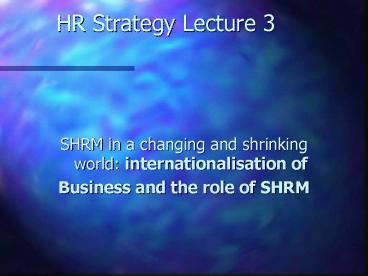HR Strategy Lecture 3 PowerPoint PPT Presentation
1 / 21
Title: HR Strategy Lecture 3
1
HR Strategy Lecture 3
- SHRM in a changing and shrinking world
internationalisation of - Business and the role of SHRM
2
SHRM in a changing and shrinking world
internationalisation of businessand the role of
SHRM
- Learning Outcomes
- By the end of this lecture you should be able to
- identify some of the key background issues
relevant to the internationalisation of business - analyse the significance in the growth of
multi-national companies - define strategic international human resource
management - identify the key components of strategic
international human resource management - explain the significance of the capability
perspective on strategic international human
resource management - evaluate the importance of the cultural
perspective on strategic international human
resource management.
3
Mapping the international strategic human
resource management territory
4
Background to the internationalisation of business
- Defining international business
- Why do companies wish to develop their
international business - The desire to access international markets
- The desire to access production advantages
offered by other countries - To grasp opportunities in developing markets
- To take advantage of financial inducements
- Following the example of competitors
- To avoid host country protectionism
5
Principal international business activities
- Import and Export (World Trade Organisation)
- Foreign direct investment (key countries and
companies) - Expansion of services and concentration of
manufacturing bases in developing economies - Licensing and Franchising
6
The importance of the multinational company
- The case for MNCs,
- The case against MNCs
- The worlds top multination companies
- New form of MNCs
- The development economies and their MNCs
- The impact of the domestic economy and employment
globalisation
7
SIHRM definition and analytical framework
- Defining SIHRM
- Strategic MNC components
- Inter-unit linkages
- Internal operations
- External factors
- Internal factors
- The MNCs competitive strategy
- The MNCs experience of international operations
8
Integrative framework of SIHRM in MNCs
9
SIHRM issues functions, policies and practices
- Inter-unit linkages
- Establishing a mix of employees in local
operation which is a mix of PCNs, HCNs and
TCNS. - Establishing HR policies and practices that link
units but allow local adaptation - Using management development to ensure
organisational coherence
10
Internal operations
- Matching and adapting HR practices with the
competitive strategy of the unit and the local
cultural and legislative system - Creating a modus operandi whereby these HR
policies can be modified to fit changing
conditions - Developing global HR policies flexible enough to
be adapted for local HR practice
11
MNC concern and goals
- Global competitiveness
- Efficiency
- Local responsiveness
- Flexibility
- Learning and transfer of knowledge
12
The capabilities needed to devise and implement
SIHRM
- Organisational capability
- Line management competencies
- The competencies of HR professionals
- The importance of communication
- The cultural perspective
13
The cultural perspective on SIHRM
- What is national culture
- How can differences in national culture be
measured - Hofstede (1980, 1991,2001) five dimensions of
national culture - Trompenaars (1993) seven distinct cultural
factors - Groupings of national cultures
14
How can differences between national cultures be
managed
- Ignoring cultural differences
- Minimising cultural differences
- Utilising cultural differences
15
What are the effects of national cultural
differences on SIHRM
- Selection
- Training
- Performance management
- Pay Rewards
16
Strategic Integration
- The Integration of HR Strategy and Corporate
Strategy - The Concept of Strategy Storey and Sisson (1993)
note that central to the very idea of HRM is the
notion that it entails a more strategic approach
to the management of people than do traditional
personnel - Strategy can be viewed at three levels
- 1) Corporate Strategy
- 2) Business or Competitive Strategy
- 3) Functional or Operational Strategy
17
Strategic Decision Making
- Purcell (1989) distinguishes between upstream
and downstream strategic decisions. - Johnson and Scholes (1993) define strategy as
the direction and scope of an organisation over
the long term ideally, which matches its
resources to its changing environment, and in
particular to its markets, customers or clients,
so as to meet stakeholder expectations - Responding to intensified competition
- Managing International operations
18
Human Resource Strategy
- Riding the Waves of Technological Innovation
- Meeting the Expectations of the Law
- Managing with or without trade unions
- Ethical Questions
- Best Practice v Best Fit
- Linking Organisational Strategy HR Strategy
- Three theoretical approaches
- 1) Universalist 2) Fit or Contingency Approach
- 3) Resource-based Approach
19
The role of the HR Function
- The HR Specialist as a Strategic thinker
- The Shift towards professionalism (CIPD)
- The advantages and disadvantages of shifting the
responsibility to line management - Strategic Human Resource Management or Strategic
Human Resource Manipulation - Key Factors Internal Technology, Organisational
Structure, Size, Life Cycle Stages, Strategic
Drive and Vision. External Legal, Social and
Political Environments, Unionisation, Labour
Market Conditions, Industry Characteristics,
National Culture
20
Evaluating HR Strategy
- Head of P/HR with a seat on the Board of
Directors - Evidence of Formal Strategy Development
- Role of the HR Function in Strategy Development
- Translation of HR Strategy into work programmes
- Performance of the HR Function Systematically
Evaluated - Criteria on which the HR function is Evaluated
- Primary responsibility for Major Policy Decisions
- Changes in Line Management Responsibility
21
Evaluating HR Strategy
- Data Collected by the HR Function
- Recruitment of Professionally qualified staff
- Towards a Strategic HR agenda
- Checklist of the role of HR (From operational to
strategic) - Expectations of the role of HR
- Adding Value, Changing the focus of HR, the
influence of HR - Summary and Discussion

